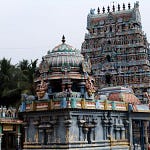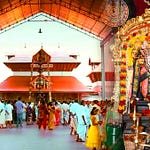Nestled amidst the towering peaks of the Garhwal Himalayas, Chandrabadni Temple is one of the most revered Shaktipeeths in India. This ancient and mystical shrine is not only a significant pilgrimage site but also a spiritual center known for its profound energy, divine aura, and mythical past. With mesmerizing Himalayan views and a rich spiritual heritage, Chandrabadni offers an unforgettable experience for devotees and travelers alike.
The temple is situated atop Chandrabadni Parvat, earlier known as Chandrakut Parvat, and stands as an epitome of faith, mysticism, and divinity.
📍 Geographical Location
District: Tehri Garhwal, Uttarakhand, India
Elevation: ~7,277 feet (2,217 meters) above sea level
Coordinates: Approx. 30.2° N, 78.5° E
Distance from Devprayag: 33 km
Distance from Rishikesh: 108 km
Nearest Town: Jamnikhal
The temple stands atop the Chandrabadni hill, formerly known as Chandrakoot Parvat, offering 360° panoramic views of snow-clad Himalayan peaks.
Origin and Historical Significance
Chandrabadni Temple is believed to mark the exact spot where the torso (trunk) of Goddess Sati fell, according to the legend of the Shaktipeeths.
✦ The Legend of Sati and Shiva:
Goddess Sati, daughter of King Daksha and consort of Lord Shiva, immolated herself at her father’s Yagna (sacrificial fire) due to his disrespect towards Lord Shiva.
Enraged and devastated, Lord Shiva carried her burning corpse across the universe, performing the destructive Tandava dance.
To calm him, Lord Vishnu used his Sudarshan Chakra to dismember Sati’s body, and her body parts fell across the Indian subcontinent — each place becoming a sacred Shaktipeeth.
Chandrabadni is one such Shaktipeeth, where it is believed that Sati’s torso (kandh or trunk) fell, imbuing the land with divine feminine energy.
Chandrabadni Temple has a profound origin rooted in ancient Hindu mythology. According to legends, when Goddess Sati sacrificed herself in the yajna performed by her father, Daksha Prajapati, Lord Shiva, in grief and anger, carried her body and wandered the universe. Lord Vishnu intervened by dismembering her body into various parts using his Sudarshana Chakra. It is believed that Sati’s torso (kabhanda) fell upon this sacred mountain, transforming it into a revered Shakti Peetha known as Chandrabadni.
Historically, Chandrabadni is mentioned in various ancient scriptures and texts, highlighting its significance as a center of spiritual energy since ancient times. The temple does not house a conventional idol; instead, a sacred Shri Yantra engraved on a stone is worshipped, symbolizing the cosmic energy and divine feminine power.
Foundation and Temple Architecture
The foundation of the current Chandrabadni Temple structure dates back several centuries, though exact historical dates remain obscure. It reflects the traditional Himalayan temple architecture, characterized by simplicity, sanctity, and natural harmony. The main temple is constructed primarily of stone, with a modest yet profound appearance. A small courtyard surrounds the main shrine, offering breathtaking panoramic views of the surrounding Garhwal Himalayan peaks and valleys.
Rituals, Puja, and Aarti
The rituals at Chandrabadni Temple are deeply spiritual, conducted by priests following age-old traditions. Daily puja rituals commence early in the morning with the ceremonial bath of the Shri Yantra, followed by sacred chants, offering flowers, incense, and lighting lamps.
The Aarti performed twice daily, at sunrise and sunset, is a deeply spiritual experience that captivates devotees. The rhythmic chants and the glowing lamps during the Aarti create an atmosphere filled with divine vibrations, spiritually uplifting devotees who participate or witness this sacred event.
Religious Importance and Significance
Chandrabadni Temple holds immense religious importance as one of the revered Shakti Peethas, symbolizing the power of the divine feminine, Adi Shakti. The Shri Yantra worshipped here represents the cosmic energies and spiritual consciousness, drawing devotees seeking blessings, strength, prosperity, and fulfillment of desires.
The temple is believed to have powerful vibrations that cleanse devotees spiritually, emotionally, and mentally. It serves as an essential pilgrimage spot, particularly for those seeking divine intervention in life's crucial matters.
Considered one of the 108 Shaktipeethas, the temple holds immense importance in the Shakta tradition of Hinduism.
Devotees believe that prayers offered here with a pure heart and unwavering devotion never go unanswered.
Many visitors experience spiritual energy and emotional purification, with several pilgrims reporting visions or dreams after visiting the temple.
It is also a center for tantric sadhana due to the presence of the Sri Yantra, which represents the union of Shiva and Shakti.
Mysteries and Insights
One of the intriguing mysteries surrounding Chandrabadni Temple is the absence of any traditional idol. The Shri Yantra symbolizes the subtle cosmic energy that transcends physical forms, offering profound spiritual insights into divine consciousness. Many devotees have reported experiencing mystical vibrations and profound tranquility upon visiting the shrine, adding to its enigmatic aura.
Chandrabadni Temple is wrapped in spiritual mystique:
The absence of a physical idol adds to its spiritual depth — making it rare among Indian temples.
The powerful vibrations around the Sri Yantra are said to be palpable to spiritually attuned individuals.
Ancient trishuls (tridents) offered by sages and devotees lie scattered around the temple, giving the aura of a battlefield of divine energies.
Some legends also claim hidden caves nearby once used by sages for meditation.
Devotee Benefits
Devotees visiting Chandrabadni Temple often experience immense peace and spiritual rejuvenation. It is believed that sincere prayers offered here are always answered, resolving conflicts, granting wishes, removing obstacles, and promoting prosperity, health, and happiness.
Travel Guide and Accessibility
Chandrabadni Temple is located approximately 33 kilometers from Devprayag, accessible by road. Devotees can reach the temple via private taxis or public transportation from prominent cities like Rishikesh, Dehradun, and Haridwar. A trek of approximately 1.5 kilometers from the nearest road leads devotees to the temple premises, offering picturesque views throughout the journey.
Mode of TravelDetails
By RoadRegular buses/taxis from Rishikesh → Devprayag → Jamnikhal → Chandrabadni.
By RailNearest station: Rishikesh (108 km)
By AirNearest airport: Jolly Grant Airport, Dehradun (123 km)
TrekLast ~1 km is a moderate trek from the roadhead to temple summit.
Temple Timings
The temple is open daily from early morning around 6:00 AM till evening around 7:00 PM. The best time to visit the temple is during early mornings or evenings to experience the serene ambiance and participate in the rituals.
Festivals and Celebrations
Significant celebrations at Chandrabadni Temple include Navratri and Vaisakhi, attracting thousands of devotees. Navratri is particularly vibrant, celebrated with elaborate rituals, special prayers, bhajans, and community feasts. During these festivities, the temple witnesses an influx of pilgrims from across the country seeking divine blessings.
Tirthas and Nearby Sacred Spots
The region surrounding Chandrabadni Temple is spiritually rich, featuring numerous nearby sacred sites, including:
Devprayag: Confluence of Alaknanda and Bhagirathi rivers, forming the sacred Ganges.
Rishikesh: Known as the gateway to the Himalayas, famous for spiritual retreats and yoga centers.
Haridwar: A revered city on the banks of the Ganges, famous for the Kumbh Mela and numerous ancient temples.
Chandrabadni Temple is not just a religious site—it is an energy vortex where nature, divinity, and mythological history coalesce. For seekers, it is a place of liberation; for believers, a place of miracles; and for travelers, a treasure trove of natural beauty and ancient wisdom. Whether you're looking to explore your faith, seek inner peace, or simply experience the cultural legacy of the Himalayas — Chandrabadni offers something truly extraordinary.










